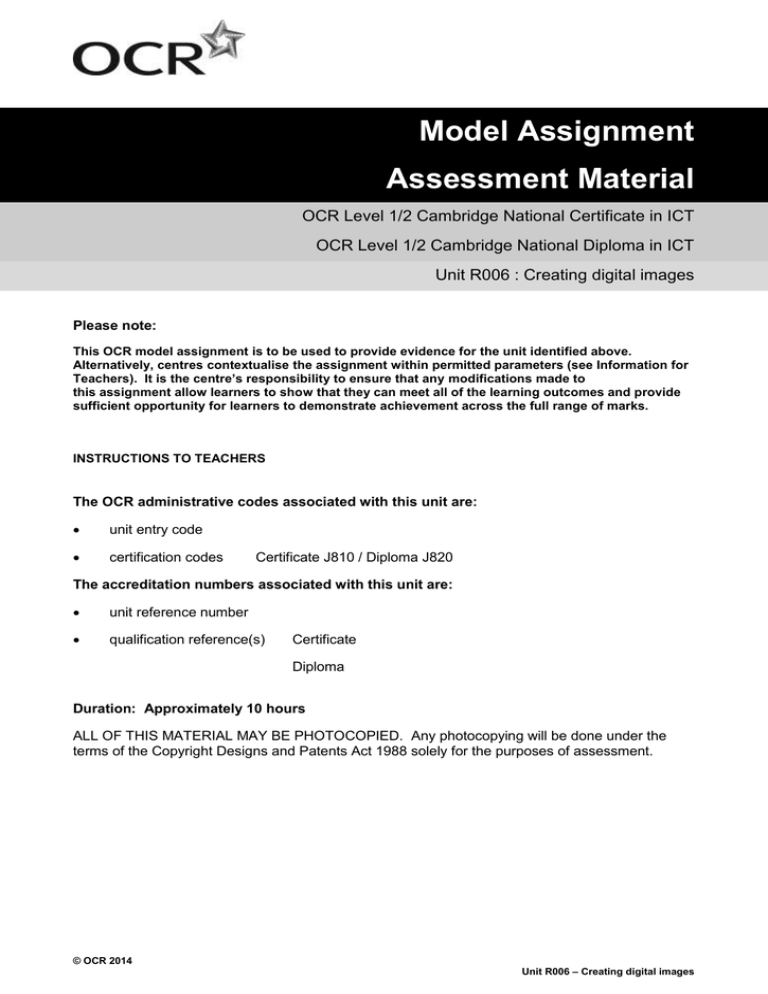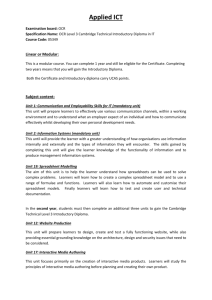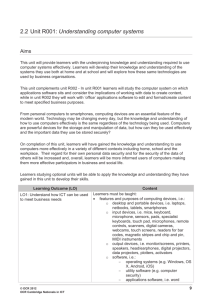Unit R006 - Creating digital images - Model assignment (DOC, 3MB)
advertisement

Model Assignment Assessment Material OCR Level 1/2 Cambridge National Certificate in ICT OCR Level 1/2 Cambridge National Diploma in ICT Unit R006 : Creating digital images Please note: This OCR model assignment is to be used to provide evidence for the unit identified above. Alternatively, centres contextualise the assignment within permitted parameters (see Information for Teachers). It is the centre’s responsibility to ensure that any modifications made to this assignment allow learners to show that they can meet all of the learning outcomes and provide sufficient opportunity for learners to demonstrate achievement across the full range of marks. INSTRUCTIONS TO TEACHERS The OCR administrative codes associated with this unit are: unit entry code certification codes Certificate J810 / Diploma J820 The accreditation numbers associated with this unit are: unit reference number qualification reference(s) Certificate Diploma Duration: Approximately 10 hours ALL OF THIS MATERIAL MAY BE PHOTOCOPIED. Any photocopying will be done under the terms of the Copyright Designs and Patents Act 1988 solely for the purposes of assessment. © OCR 2014 Unit R006 – Creating digital images OCR Level 1/2 Cambridge Nationals in ICT Contents Page Number(s) INFORMATION FOR LEARNERS Scenario for the assignment This section contains the assignment background which learners will need to be familiar with in order to complete the tasks. Your Tasks This section contains all the tasks learners must complete before work can be submitted for assessment. INFORMATION FOR TEACHERS Guidance on using this assignment This section provides guidance to centre staff on the preparation and completion of the assignment. 3 4 5-6 7 8 - 10 2 Unit R006 – Creating digital images Model Assignment: Information for Learners OCR Level 1/2 Cambridge National Certificate in ICT OCR Level 1/2 Cambridge National Diploma in ICT Unit R006 : Creating digital images © OCR 2014 Unit R006 – Creating digital images OCR Level 1/2 Cambridge Nationals in ICT Scenario for the Assignment Keep Pets ‘Keep Pets’ is a local, family-run pet shop that was established over 40 years ago. A new owner, Sam, has just bought the shop. The original shop logo, shown on the right, is still in use and is a silhouette of a cat, a dog and the company name. Sam has decided to update the shop’s image using digital media. Sam wants to change its old-fashioned image to reflect the fact that the shop is now a modern business, selling a wide range of pets and pet supplies. Sam does not wish to keep the old logo and has asked you to create a new one. Sam also wants you to design artwork, using composite digital images, that reflects the company’s friendly service and aspects of the company’s slogan - ‘Keep Pets Safe, Healthy and Fit’. The digital artwork that you design will be used in the shop and on the company’s website. The artwork may need to be scaled up later, to a much larger size, by a printing company. Read through all of the tasks carefully, so that you know what you will need to do to complete this assignment. Important You will need to have access to the marking criteria. Your teacher can explain the marking criteria if you need further clarification. You will need to draw upon relevant skills/knowledge/understanding from other units you have studied in this qualification. 4 Unit R006 – Creating digital images OCR Level 1/2 Cambridge Nationals in ICT Your Tasks Task 1 – Specify a digital image solution for the client’s needs Learning Outcome 1 is assessed in this task A. B. Produce a specification for your client that includes: user requirements success criteria your research ideas for your solution creative design plans Source and store components for inclusion in your digital image solution, taking account of any relevant legislation. Make a list of all the components you have stored. Explain why you have chosen each component and explain the legal implications of using each of them in your solution. Task 2 – Create the digital image solution Parts of Learning Outcomes 2 and 3 are assessed in this task To create your solution you will need to: choose software set the image size and/or resolution as appropriate for your output formats use software tools and techniques to create your digital artwork store all your files so they can be easily located. Explain how your choices of software, image sizes and resolution would meet your client’s requirements. 5 Unit R006 – Creating Digital Images OCR Level 1/2 Cambridge Nationals in ICT Task 3 – Present and evaluate Parts of Learning Outcomes 2 and 3 are assessed in this task A. Present your final digital image solution in an appropriate format. B. Review digital images created by another person and provide constructive feedback on these images. C. Evaluate your solution, considering the client’s requirements and your success criteria. 6 Unit R006 – Creating digital images Information for Teachers OCR Level 1/2 Cambridge National Certificate in ICT OCR Level 1/2 Cambridge National Diploma in ICT Unit R006 : Creating digital images © OCR 2014 Unit R006 – Creating digital images OCR Level 1/2 Cambridge Nationals in ICT Guidance on using this assignment 1 2 3 General guidance 1.1 OCR assignments are available to download free of charge from our website: www.ocr.org.uk 1.2 OCR assignments are intended to be used for summative assessment of learners. The OCR specification gives more information on the arrangements for assessing internally assessed units. 1.3 This assignment has been designed to meet the full assessment requirements of the unit. Learners will need to take part in a planned learning programme that covers the underpinning knowledge, understanding and skills of the unit. Before carrying out the assignment 2.1 Learners should be provided with a copy of the Information for Learners section of this assignment. 2.2 Learners will not need to carry out any preparations prior to undertaking the assessment tasks, such as collating resources to use in the assessment. 2.3 We have estimated that it will take approximately 10 hours to complete these tasks. This is the recommended time but centres can decide how the time can be allocated between each individual task in the assessment. Centres are also permitted to spread the overall assessment time across several sessions and therefore it is permissible for evidence to be produced over several sessions. When completing the assignment and producing evidence 3.1 Each learner must produce individual and authentic evidence for each task within the assignment. 3.2 Centre staff may give support and guidance to learners. This support and guidance should focus on checking that learners understand what is expected of them and giving general feedback that enables the learner to take the initiative in making improvements, rather than detailing what amendments should be made. It is not acceptable for teachers/deliverers to provide answers, to work through answers in detail or to detail specifically what amendments should be made. 3.3 Learners may use information from any relevant source to help them with producing evidence for the tasks. 3.4 Learners must be guided on the use of information from other sources to ensure that confidentiality is maintained at all times. 3.5 We have specified what evidence the learner is expected to produce. Usually, the type of evidence provided may be modified, with the exception of certain types of evidence listed below under ‘Permitted changes’. It is important to note that it is possible to generate the evidence in a variety of formats. Centres must advise learners as to the most appropriate format of evidence. The nature of this assessment means that learners are free to use the format that they feel is most appropriate for the purpose and target audience for each individual task. 8 Unit R006 – Creating digital images OCR Level 1/2 Cambridge Nationals in ICT 4 5 Presentation of work for marking and moderation 4.1 Centres wishing to produce digital evidence in the form of an e-portfolio should refer to the appendix in the specification on guidance for the production of electronic assessment. 4.2 Centres may wish to discourage learners from excessive use of plastic wallets for presentation of their evidence as this may hinder the assessment process. Instead centres may wish to encourage learners to present their work so that it is easily accessible, e.g. spiral bound, stapled booklet, treasury tag. Scope of permitted model assignment modification The model assignment is self-contained in its present form. The set of tasks form a coherent whole addressing all the learning outcomes and allowing access to the full range of marks. You must not change the following: the learning outcomes the marking criteria the requirements for supervision and authentication as described in the specification (Section 4 The centre assessed units). Permitted Changes: The model assignment can be modified in terms of the areas described below but centres must be sure that learners still have the opportunity to cover all of the learning outcomes and to access the full range of marks: The scenario can be replaced to meet local needs, or may be contextualised by changing specific details such as the name of the company. No changes should be made to the tasks. OCR has ensured that in the language used and the tasks and scenario provided we have avoided discrimination, bias and stereotyping and support equality and diversity. In the development of qualifications and assessments we use the guidance given in the Ofqual publication Fair access by design, notably this includes: using language and layout in assessment materials that does not present barriers to learners using stimulus and source materials in assessment materials (where appropriate) that do not present barriers to learners. If centres wish to modify the model assignment we strongly advise that staff responsible for modifying the model assignment and the quality assurance of it refer to the publication Fair access by design. If modifications are made to the model assignment, as detailed above to the scenario only, then the individual tasks from this model assignment should be used. It is up to the centre to ensure that all tasks and learning outcomes can still be met and that learners can access the full range of marks. 9 Unit R006 – Creating Digital Images OCR Level 1/2 Cambridge Nationals in ICT 6 Specific guidance on the task When completing this assignment it may be possible to generate evidence for completing a task in a variety of formats. A list of appropriate filetypes in the specification, provides examples of the formats that can be used, it is not exhaustive. In some cases the task or assignment will require a specific format for the outcome and this will be clearly marked with an asterisk in the table. Learners should be provided with a copy of the marking criteria for this unit, when completing the assignment. Teachers should ensure that the candidates understand the marking criteria and may explain it to them. Learners will need to be given access to a range of digital image components from which they can choose. Learners must not be expected to create their own components, although they may wish to do so. The unit assesses the extent to which learners are able to create digital images which communicate the intended message. Digital images for review in Task 3 may be those created by other candidates or could be provided by the centre. Candidates are assessed on the quality of feedback they give to others, therefore evidence of the feedback they have given for another’s digital image must be included in their own portfolio. For further information on assessment and evidence please see specific unit assessment guidance included with the marking criteria in the specification. 10 Unit R006 – Creating digital images

